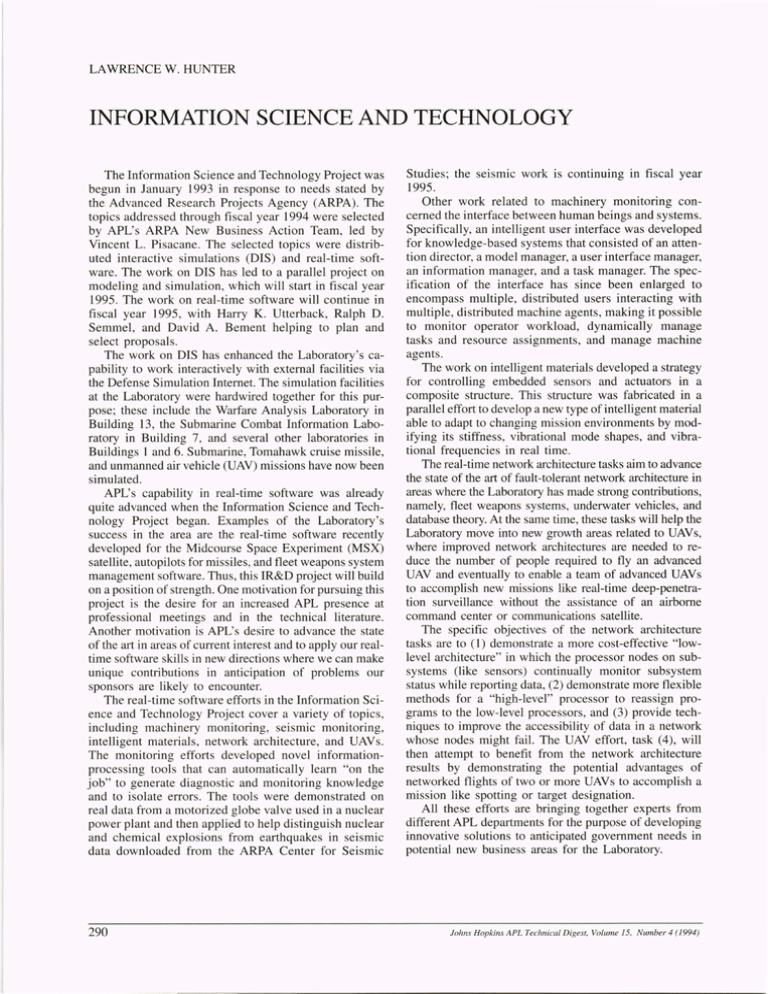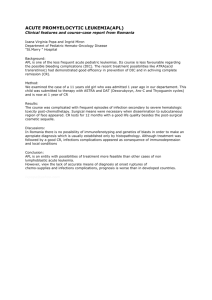INFORMATION SCIENCE AND TECHNOLOGY
advertisement

LAWRENCE W. HUNTER INFORMATION SCIENCE AND TECHNOLOGY The Information Science and Technology Project was begun in January 1993 in response to needs stated by the Advanced Research Projects Agency (ARPA). The topics addressed through fiscal year 1994 were selected by APL's ARPA New Business Action Team, led by Vincent L. Pisacane. The selected topics were distributed interactive simulations (DIS) and real-time software. The work on DIS has led to a parallel project on modeling and simulation, which will start in fiscal year 1995. The work on real-time software will continue in fiscal year 1995, with Harry K. Utterback, Ralph D. Semmel, and David A. Bement helping to plan and select proposals. The work on DIS has enhanced the Laboratory's capability to work interactively with external facilities via the Defense Simulation Internet. The simulation facilities at the Laboratory were hardwired together for this purpose; these include the Warfare Analysis Laboratory in Building l3 , the Submarine Combat Information Laboratory in Building 7, and several other laboratories in Buildings 1 and 6. Submarine, Tomahawk cruise missile, and unmanned air vehicle (UAV) missions have now been simulated. APL's capability in real-time software was already quite advanced when the Information Science and Technology Project began. Examples of the Laboratory 's success in the area are the real-time software recently developed for the Midcourse Space Experiment (MSX) satellite, autopilots for missiles, and fleet weapons system management software. Thus, this !R&D project will build on a position of strength. One motivation for pursuing this project i the desire for an increased APL presence at professional meetings and in the technical literature. Another motivation is APL's desire to advance the state of the art in areas of current interest and to apply our realtime software skills in new directions where we can make unique contributions in anticipation of problems our sponsors are likely to encounter. The real-time software efforts in the Information Science and Technology Project cover a variety of topics, including machinery monitoring, seismic monitoring, intelligent materials, network architecture, and UAV s. The monitoring efforts developed novel informationprocessing tools that can automatically learn "on the job" to generate diagnostic and monitoring knowledge and to isolate errors. The tools were demonstrated on real data from a motorized globe valve used in a nuclear power plant and then applied to help distinguish nuclear and chemical explosions from earthquakes in seismic data downloaded from the ARPA Center for Seismic 290 Studies; the seismic work is continuing in fiscal year 1995. Other work related to machinery monitoring concerned the interface between human beings and systems. Specifically, an intelligent user interface was developed for knowledge-based systems that consisted of an attention director, a model manager, a user interface manager, an information manager, and a task manager. The specification of the interface has since been enlarged to encompass multiple, distributed users interacting with multiple, distributed machine agents, making it possible to monitor operator workload, dynamically manage tasks and resource assignments, and manage machine agents . The work on intelligent materials developed a strategy for controlling embedded sen ors and actuators in a composite structure. This structure was fabricated in a parallel effort to develop a new type of intelligent material able to adapt to changing mission environments by modifying its stiffness, vibrational mode shapes, and vibrational frequencies in real time. The real-time network architecture tasks aim to advance the state of the art of fault-tolerant network architecture in areas where the Laboratory has made strong contributions, namely, fleet weapons systems, underwater vehicles, and database theory. At the same time, these tasks will help the Laboratory move into new growth areas related to UAVs, where improved network architectures are needed to reduce the number of people required to fly an advanced UAV and eventually to enable a team of advanced UAVs to accomplish new missions like real-time deep-penetration surveillance without the assistance of an airborne command center or communications satellite. The specific objectives of the network architecture tasks are to (1) demonstrate a more cost-effective "lowlevel architecture" in which the processor nodes on subsystems (like sensors) continually monitor subsystem status while reporting data, (2) demonstrate more flexible methods for a "high-level" processor to reassign programs to the low-level processors, and (3) provide techniques to improve the acces ibility of data in a network whose nodes might fail. The UAV effort, task (4), will then attempt to benefit from the network architecture results by demonstrating the potential advantages of networked flights of two or more UAV s to accomplish a mission like spotting or target designation. All these efforts are bringing together experts from different APL departments for the purpose of developing innovative solutions to anticipated government needs in potential new business areas for the Laboratory. Johns Hopkins APL Technical Digest, Volume 15, Number 4 (1994) THE AUTHOR LAWRENCE W. HUNTER is a member of APL's Principal Professional Staff. He recei ved a B.Sc. (hons), fIrst class, in chemistry from Carleton University (Ottawa, Canada) in 1967 and a Ph.D. in theoretical chemistry from the University of Wisconsin, Madi on, in 1972. He has been employed at APL si nce 1973 and was named Aeronautics Department IR&D coordinator in 1985. He led the Advanced Materials Technology Insertion !R&D thrust area and has been coordinating the Information Science and Technology thrust area since its inception in January 1993. He has contributed to 80 refereed publications in diverse fIelds , including spectroscopy, molecular collision theory, transport properties of gases, combustion and flame experiments, fIre propagation modeling, heat transfer, ablation and phase change modeling, advanced materials, and chemical propulsion. One paper is included in the list of "most frequently cited APL publications." f ohns Hopkins APL Technical Digest, Volume 15, Number 4 (1994) 291



